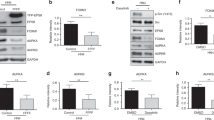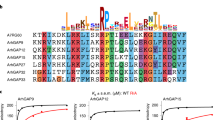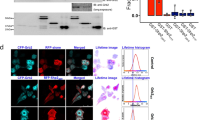Abstract
Mutations within members of the EGF/ErbB receptor family frequently release the oncogenic potential of these receptors, resulting in the activation of downstream signaling events independent of ligand regulatory constraints. We previously have demonstrated that the signal transduction events originating from S3-v-ErbB, a ligand-independent, oncogenic EGF receptor mutant, are qualitatively distinct from the ligand-dependent mitogenic signaling pathways associated with the wild-type EGF receptor. Specifically, expression of S3-v-ErbB in primary fibroblasts results in anchorage-independent growth, increased invasive potential, and the formation of a transformation-specific phosphoprotein signaling complex, all in a Ras-independent manner. Here we demonstrate the transformation-specific interaction between two components of this complex: the adaptor protein Grb2 and the cytoskeletal regulatory protein caldesmon. This interaction is mediated via both the amino-terminal SH3 and central SH2 domains of Grb2, and the amino-terminal (myosin-binding) domain of caldesmon. Expression of a dominant-negative Grb2 deletion mutant, which lacks the carboxy-terminal SH3 domain, in fibroblasts expressing S3-v-ErbB results in a reduction in phosphoprotein complex formation, the loss of anchorage-independent growth, and a reduction in invasive potential. Together, these results demonstrate a Ras-independent role for Grb2 in modulating cytoskeletal function during ligand-independent EGF receptor-mediated transformation, and provide further support for the hypothesis that ligand-independent oncogenic signaling is qualitatively distinct from ligand-dependent mitogenic signaling by the EGF receptor.
This is a preview of subscription content, access via your institution
Access options
Subscribe to this journal
Receive 50 print issues and online access
$259.00 per year
only $5.18 per issue
Buy this article
- Purchase on Springer Link
- Instant access to full article PDF
Prices may be subject to local taxes which are calculated during checkout









Similar content being viewed by others
References
Adelsman MA, Huntley BK and Maihle NJ . (1996). J. Virol., 70, 2533–2544.
Aftab DT, Kwan J and Martin GS . (1997). Proc. Natl. Acad. Sci. USA, 94, 3028–3033.
Albini A, Iwamoto Y, Kleinman HK, Martin GR, Aaronson SA, Kozlowski JM and McEwan RN . (1987). Cancer Res., 47, 3239–3245.
Bell SM, Connolly DC, Maihle NJ and Degen JL . (1993). Mol. Cell. Biol., 13, 5888–5897.
Boerner JL, Danielsen AJ and Maihle, NJ . (2003). Exp. Cell Res., 284, 111–121.
Boerner J, McManus M, Martin G and Maihle N . (2000). J. Cell Sci., 113, 935–942.
Boerner JL, Danielsen AJ, McManus MJ and Maihle NJ . (2001). J. Biol. Chem., 276, 3691–3695.
Chardin P, Camonis JH, Gale NW, van Aelst L, Schlessinger J, Wigler MH and Bar-Sagi D . (1993). Science, 260, 1338–1343.
Cheng AM, Saxton TM, Sakai R, Kulkarni S, Mbamalu G, Vogel W, Tortorice CG, Cardiff RD, Cross JC, Muller WJ and Pawson T . (1998). Cell, 95, 793–803.
Connolly DC, Toutenhoofd SL and Maihle NJ . (1994). J. Virol., 68, 6804–6810.
Daly RJ, Binder MD and Sutherland RL . (1994). Oncogene, 9, 2723–2727.
D'Ambrosio C, Hongo A, Li S and Baserga R . (1996). Oncogene, 12, 371–378.
Dankort D, Jeyabalan N, Jones N, Dumont DJ and Muller WJ . (2001a). J. Biol. Chem., 276, 38921–38928.
Dankort D, Maslikowski B, Warner N, Kanno N, Kim H, Wang Z, Moran MF, Oshima RG, Cardiff RD and Muller WJ . (2001b). Mol. Cell. Biol., 21, 1540–1551.
Gale NW, Kaplan S, Lowenstein EJ, Schlessinger J and Bar-Sagi D . (1993). Nature, 363, 88–92.
Gay B, Suarez S, Weber C, Rahuel J, Fabbro D, Furet P, Caravatti G and Schoepfer J . (1999). J. Biol. Chem., 274, 23311–23315.
Goncharova EA, Shirinsky VP, Shevelev AY, Marston SB and Vorotnikov AV . (2001). FEBS Lett., 497, 113–117.
Huang HS, Nagane M, Klingbeil CK, Lin H, Nishikawa R, Ji XD, Huang CM, Gill GN, Wiley HS and Cavenee WK . (1997). J. Biol. Chem., 272, 2927–2935.
Hughes S and Kosik E . (1984). Virology, 136, 89–99.
Klapper LN, Kirschbaum MH, Sela M and Yarden Y . (2000). Adv. Cancer Res., 77, 25–79.
Li N, Batzer A, Daly R, Yajnik V, Skolnik E, Chardin P, Bar-Sagi D, Margolis B and Schlessinger J . (1993). Nature, 363, 85–88.
Lowenstein EJ, Daly RJ, Batzer AG, Li W, Margolis B, Lammers R, Ullrich A, Skolnik EY, Bar-Sagi D and Schlessinger J . (1992). Cell, 70, 431–442.
Maihle NJ and Kung HJ . (1989). Biochim. Biophys. Acta, 948, 287–304.
Maihle NJ, Raines MA, Flickinger TW and Kung HJ . (1988). Mol. Cell. Biol., 8, 4868–4876.
Marston SB and Redwood CS . (1991). Biochem. J., 279, 1–16.
Matsumura F and Yamashiro S . (1993). Curr. Opin. Cell. Biol., 5, 70–76.
McManus MJ, Boerner JL, Danielsen AJ, Wang Z, Matsumura F and Maihle NJ . (2000). J. Biol. Chem., 275, 35328–35334.
McManus MJ, Connolly DC and Maihle NJ . (1997). J. Virol., 69, 3631–3638.
McManus MJ, Lingle WL, Salisbury JL and Maihle NJ . (1997). Proc. Natl. Acad. Sci. USA, 94, 11351–11356.
Nair N, Davis RJ and Robinson HL . (1992). Mol. Cell Biol., 12, 2010–2016.
Owada MK, Hakura A, Iida K, Yahara I, Sobue K and Kakiuchi S . (1984). Proc. Natl. Acad. Sci. USA, 81, 3133–3137.
Pawson T, Olivier P, Rozakis-Adcock M, McGlade J and Henkemeyer M . (1993). Philos. Trans. R. Soc. Lond. B, 340, 279–285.
Penington DJ, Bryant I and Riese II DJ . (2002). Cell Growth Differ., 13, 247–256.
Puto LA, Pestonjamasp K, King CC and Bokoch GM . (2003). J. Biol. Chem., 278, 9388–9393.
Raines MA, Maihle NJ, Moscovici C, Crittenden L and Kung HJ . (1988a). J. Virol., 62, 2437–2443.
Raines MA, Maihle NJ, Moscovici C, Moscovici MG and Kung HJ . (1988b). J. Virol., 62, 2444–2452.
Renkema GH, Pulkkinen K and Saksela K . (2002). Mol. Cell. Biol., 22, 6719–6725.
Rochefort H, Platet N, Hayashido Y, Derocq D, Lucas A, Cunat S and Garcia M . (1998). J. Steroid Biochem. Mol. Biol., 65, 163–168.
Rozakis-Adcock M, Fernley R, Wade J, Pawson T and Bowtell D . (1993). Nature, 363, 83–85.
Salomon DS, Brandt R, Ciardiello F and Normanno N . (1995). Crit. Rev. Oncol. Hematol., 19, 183–232.
Sato H, Takino T, Okada Y, Cao J, Shinagawa A, Yamamoto E and Seiki M . (1994). Nature, 370, 61–65.
Saucier C, Papavasiliou V, Palazzo A, Naujokas MA, Kremer R and Park M . (2002). Oncogene, 21, 1800–1811.
Tanaka J, Watanabe T, Nakamura N and Sobue K . (1993). J. Cell Sci., 104, 595–606.
Tari AM, Hung MC, Li K and Lopez-Berestein G . (1999). Oncogene, 18, 1325–1332.
Wang Z, Danielsen AJ, Maihle NJ and McManus MJ . (1999). J. Biol. Chem., 274, 33807–33813.
Xie Y, Pendergast AM and Hung MC . (1995). J. Biol. Chem., 270, 30717–30724.
Yamashiro S, Yoshida K, Yamakita Y and Matsumura F . (1994). Adv. Exp. Med. Biol., 358, 113–122.
Acknowledgements
We gratefully acknowledge Dr Stephen Hughes (NCI) for providing the RCAN/RCAS retroviral vectors used in these studies, Dr AM Prendergast for providing the wild-type and ΔC mutant Grb2 cDNAs, Dr P Findell for providing the Gst-Grb2 fusion construct, and Dr T Pawson for providing the Gst-N-SH3, Gst-SH2, and Gst-C-SH3 constructs. We also thank Trace Christensen, Shari Meeker, Laura Sikkink, and Emily Ward for their technical contributions, and Drs Jill Reiter, Hakjoo Lee, and Mike McManus for their technical assistance and helpful discussions. This work was supported by the National Institutes of Health (CA79808).
Author information
Authors and Affiliations
Corresponding author
Rights and permissions
About this article
Cite this article
Boerner, J., Danielsen, A., Lovejoy, C. et al. Grb2 regulation of the actin-based cytoskeleton is required for ligand-independent EGF receptor-mediated oncogenesis. Oncogene 22, 6679–6689 (2003). https://doi.org/10.1038/sj.onc.1206830
Received:
Revised:
Accepted:
Published:
Issue Date:
DOI: https://doi.org/10.1038/sj.onc.1206830
Keywords
This article is cited by
-
Phosphorylation of caldesmon during smooth muscle contraction and cell migration or proliferation
Journal of Biomedical Science (2006)



